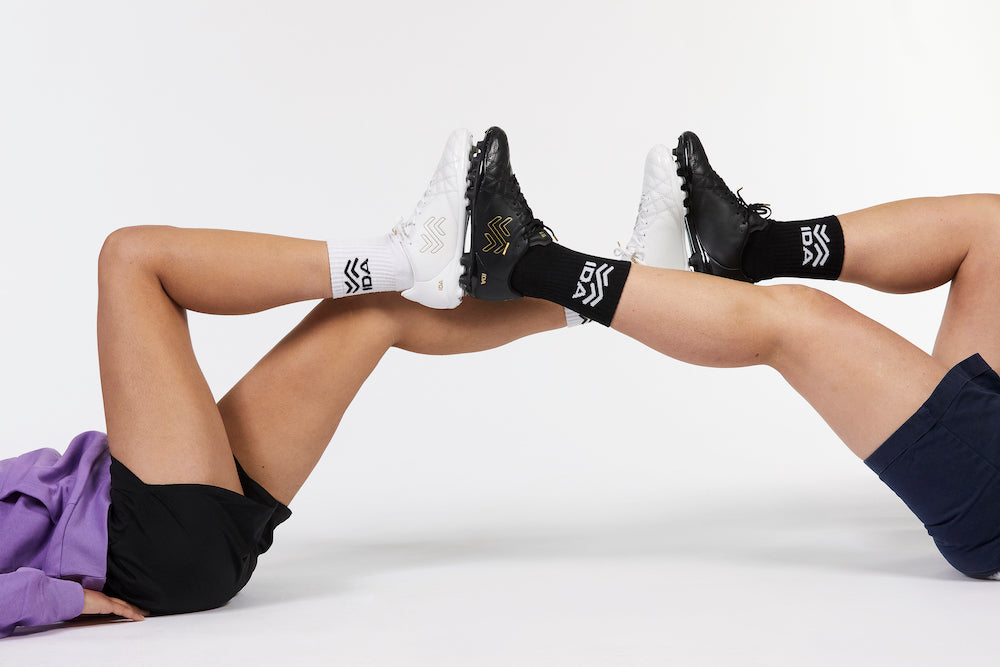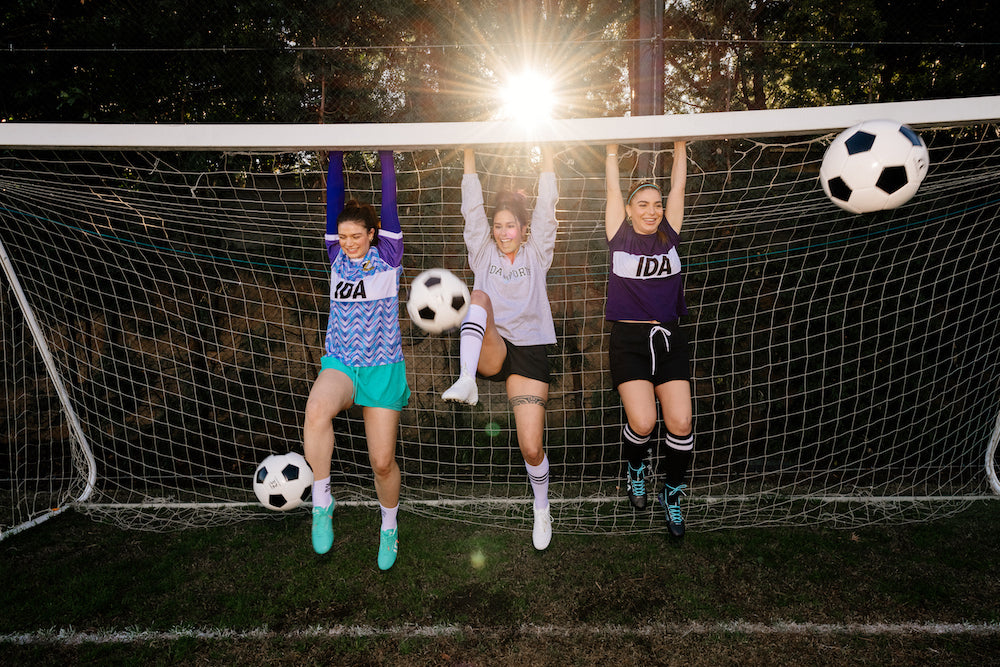This week, we're excited to present a very special Brand Spotlight – focussed on IDA Sports.
IDA Sports create football boots and shoes for female players. It will surprise no one to know there's a huge demand for such products... but it is truly shocking to learn just how underserved the industry has been until now. Women and girls have traditionally had to play football in what are essentially just small-sized men's boots, despite the significant biomechanical differences between men's and women's bodies.
As a result, the work being done by IDA Sports has the potential to truly revolutionise the women's game. Doug Cook from IDA Sports was kind enough to tell us more.
A Conversation with Doug Cook
Doug Cook is the Chief of Staff at IDA Sports. He has been formally working with the company for eight months, though really, he was present in some form or another since the very beginning – when IDA Sports was started by his partner, Laura Youngson, now CEO, and her co-founder Ben Sandhu.
Doug, thank you so much for speaking with us. Can you tell us a little about the inception of IDA Sports? How did it all come about?
It came out of frustration. It came out of pain, it was born of the idea that it didn't need to be uncomfortable for women to play football. Or Aussie Rules, or rugby, or for that matter, any sports.
The industry term for the provision of women's shoes in these sports has historically been – and I quote – “Shrink it and pink it.” That’s literally what they have done. They take a men's product and they produce smaller sizes, and market it to women as a woman's product.
The problem with that is there’s a biomechanical issue – beyond just aesthetics. These sportswomen are left trying to perform wearing stuff that’s fundamentally not designed for them.
The first problem is the shoes will actually feel uncomfortable. If you go out there and take a random sampling of friends, any females who play a team sport, and ask, “Are your shoes comfortable?” The first thing they’ll say is No! They'll probably talk to you about things like blisters, pressure on the Achilles, pressure in the heel. This is because the shoe was designed around foot shape, and a mould (or ‘last’ as it's called in the industry) that is made for a men's foot. And the ratios are fundamentally different.

According to a report from the European Club Association, as many as 82% of female players experienced high discomfort from wearing football boots. Many said this had negatively affected their playing. So IDA Sports set out to do something different?
Exactly. For the first two years, IDA Sports involved Laura [Youngson], along with colleagues from different universities in Australia and the UK, looking at the biomechanics of men's versus women's feet. They looked at public research, everything available, to determine how you would design the best possible football boot for women.
They made the first one in our kitchen in Melbourne, and the smell of melting rubber and burnt plastic was in our house for literally a month! It was horrible. Now it’s jokingly called the “Frankenshoe,” and it's in the Design Museum in London. It’s a horrendous looking shoe and it's never been worn, ironically, as it's just one shoe rather than a pair. But the objective was to prove that you could indeed make a shoe for female bodies, which took into account the biomechanics, the different pivot points, and so on.
So in business terms, what does the IDA Sports model look like? And what are your main objectives?
The objective of the company is to change the industry. The fact that Puma and Nike and others are now finally starting to make women's shoes is great, because the goal has always been to bring more options in women’s boots to the market..
Back when IDA Sports started in 2018, there was a bit of mockery and derision. Laura's female, obviously, and female founders get roughly 2% of the venture capital market’s money (that's borne out by The New York Times and Harvard Business Review). But she survived the odds, and here we are.
By 2020, we had our first boots on feet. We were just in Australia at this point in time and we sold them all locally in the Melbourne area to clubs and other relationships we’d built.
The critical thing for us though, was when we asked them: How does it perform? And these players were ecstatic. We had one, who plays at the professional level in Australia, say, “I wore the boots for an entire game and my feet did not feel tired afterwards. I've never had that in my entire playing career.”
That was the point where Laura and Ben knew they were onto something. The first 1000 pairs were financed privately, but at that point they opened the first loan vehicle for the project, allowing friends and family to invest in the company – and that allowed us to produce more shoes, and make them even better.

How did you make the jump to becoming an international company?
In late 2020, we had the opportunity to enter the US via a retailer partnership with Dick’s Sporting Goods, the largest sporting goods retailer in the US. This relationship shined a light on the scale of the opportunity that existed within the USA and then also the UK.
Simultaneously, Laura and I had relocated to Gloucester – not too far up the road from Alvio – and then we hired some colleagues in the US. We continued to strike up relationships with buyers and more retailers in the US, so we now sell through even more major US retailers like Academy Sports + Outdoors and Soccer.com.
And how does sports retail look in the UK, in your experience?
In the UK, we’ve adopted a somewhat different approach, and this is what brought us to Alvio in the first place.
Helen Hardy, the co-founder of Foudys, is a close friend of Laura's, so we've always known each other – joint passions, parallel companies, you get the idea. So early on, we reached out to Helen and said: “Listen, we make boots, you do the strips and the kits. Let's collaborate on this!”
And Helen tells us: “Okay, well, we use this thing called Alvio. It basically allows us to connect our Shopify stores, sell each other’s stuff, help each other out, and so on.”
Now here’s what I like about Alvio: In theory, I could make my own relationship with these other brands, right? I could go to them directly, send them our stock images, our pricing, and some text to put on their websites. But that’s all a lot of work. It’s a lot of effort and for no guaranteed return. But the thing that Alvio has done is to make it really easy just to give it a go.
We're scientists by background. So we start with the hypothesis that this is a transfer of value and everybody will win. Thanks to Alvio, we can then test that hypothesis pretty quickly. And if it does work, amazing. Maybe it becomes a scalable channel, and we can sell lots of shoes. It means we can broaden our partner network really easily. And both parties can figure out if it makes sense for them with a very, very low transaction cost.
So when I saw all this, of course, I picked up the phone to Alvio. Hello Mike, I'm Doug. And the rest is history.

So you’ve naturally gravitated more towards a partnership model for your UK trade?
Exactly. Using services like Alvio and Huboo has helped us service non-traditional retailers and build relationships with grassroots clubs.
This is also around the time we came into contact with London Seaward FC, an Alvio connection too. Through our partnership with them, every player who buys boots through London Seaward actually helps the club.
It’s the same boots they’re buying, at exactly the same price. But now there's a decent chunk of the revenue actually going into the club. And that sale, direct through the club, means that – for example, those new nets that you wanted? Or that clubhouse renovation that you wanted? Or the new balls, or whatever it is… maybe now they can actually afford it. We are delighted with that. Because supporting women's grassroots football is the entire objective of the exercise.
So to come full circle, selling boots was never the only reason Lauren and Ben founded IDA Sports. They wanted to professionalise and change the women's game. And we’re now seeing the reality of that model, and it’s exciting.
Where do you see it going from here? What does the future of your partnership model look like?
Alright, so that was just one example. But once we got our heads around that, then we realised – anyone could be a retailer. Then it becomes about partnerships. Who wants to do what within this space?
You've got the likes of Jonas Sports Retail who supply a lot of backend digital services to all kinds of clubs. That's a hugely valuable tool right there. Then you've got companies like us who make stuff. So we make boots… but there’s other companies who make things like period pants or waterproof mascara, or you name it, anything that a female soccer player could need. And then you realise that this can all be channelled in such a way that those purchases support the clubs first and foremost.
It’s a business model facilitated and enabled by the likes of Jonas, and the lubricant – for lack of a better term – is a platform like Alvio. And then the stock is effectively drop-shipped. Which results in a lower cost base, a better shopping experience, plus the sale directly supports the thing the customer wants.
So yeah, we are super, super excited about it all.
That’s the thing about digital partnerships going into 2024… we’re reaching the point where you're only constrained by your imagination.

It seems that women’s football is having a real boost in attention lately. From the British perspective, this was obviously helped a huge amount by the Lionesses winning the Euro 2022 finals. Where do you see things going from here?
We've got the Olympics coming up in France this summer. We've got the Euros in Switzerland in 2025. We've got the under 20s Women's World Cup in Colombia in August, September. The professionalisation of the women's game has gone from being a sort of whispered hush-hush movement, to a stampede.
If you look at the investments that are being made, the TV rights are selling for serious money, the stadiums are getting sold out. I’ve been close to women's football for well over a decade and I’ve watched the change – this is no longer a marginalised concept. More and more girls are playing, which is not just good for us commercially, but we believe it’s good for society! It brings joy and fitness and health.
Today there's about 3.4 million women in the UK playing on a football team at varying levels. Whether that's in the park at the weekend, with a local team, or in the Premier League. It’s a huge number, and it’s going up. The visibility of the women’s game is being raised all the time, for example when the Lionesses won the 2022 Euros it immediately attracted more girls to try for local teams. But it’s a truly global sport. In the US, it's been a women's sport for decades, and they have about 4-4.5 million registered players.
And what about IDA Sports? Do you have plans for expansion to meet this market? For example, are there other products you’ve thought about offering?
We've had so much customer feedback – customers in our world are incredibly loyal. And if we ask, the answers we get are quite phenomenal. For example they tell us which colours they prefer, and then those are the colours we’re producing. We ask which types of cleats should we make? Do players want indoor shoes? And the players overwhelmingly said they needed an astroturf shoe, because that’s where more and more training happens.
And then we also find people wear our shoes for lifestyle purposes. Because they’re made and designed exclusively for women, to be comfortable, and so what happens is women end up wearing them to the shops. I mean, Laura wears hers all the time (and not just because she's the CEO!).
Then we get the requests, often multiple requests a day, asking about boots for other sports. The other day, we heard from the Irish Women's Rugby Union. We told them, “You are aware these are football boots? And technically they're slightly different.”
But they said, “Yeah, we know, but they fit comfortably and we think they’re more supportive compared to wearing men’s football boots.”
Though in theory, we could make rugby boots. We've got all the R&D, and all the science now… So who knows where we’ll go from here. All we know for sure is that the demand for women’s sportswear is overwhelming right now – and we plan to keep growing to meet it.




